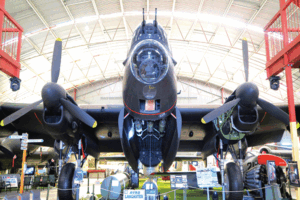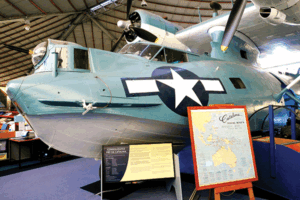Charles Page
If ever you need an incentive to travel to Bull Creek, Perth, you will be well rewarded by a visit to the Aviation Heritage Museum of Western Australia. The museum is owned and operated by RAAFA (WA) and located at Air Force Memorial Estate, Bull Creek, just off the Kwinana Freeway, or a ten minute train ride from Perth. The museum has aircraft and displays that you won’t find anywhere else in Australia, and although it makes for a great day out, you may wish to spend more than one day there. It is family friendly, and accessible, and as nearly all the exhibits are under cover, it is also a good rainy day outing.
Entrance is via the well stocked gift shop, with a selection of souvenirs, models and books. While the museum can be self guided, there are always volunteer guides available and a visit will be enhanced by their enthusiasm and knowledge. Their camaraderie brings the museum to life, and volunteers also staff the counter, library, accessions, photo library, models, displays, simulators, restoration, maintenance and workshop.
The museum has its origins in 1971, when the Aviation Historical Group began collecting and restoring aircraft. Then in 1979, the south hangar was opened, with the aid of a State Government grant. The north hangar opened in 1983, and the east hangar in 2023.
Meanwhile, a Spitfire Mk 22 was acquired from the UK in 1959 and mounted on a pylon outside RAAFA’s Memorial House on Adelaide Terrace, Perth. With the completion of the Air Force Memorial Estate at Bull Creek in 1971, the Spitfire was mounted at the estate entrance. However, after corrosion was found, it was restored and repainted by No 25 Squadron before moving to the north hangar in 1985. It was replaced on the pylon by a fibreglass replica Spitfire Mk 16 with clipped wings.
In another coup for the museum, it was learned that the French Aeronautique Navale were disposing of their Lancasters in 1962. After much diplomatic activity, a French crew, led by Capitaine de Corvette Henri Martini, flew Lancaster WU16 from Noumea to Sydney, Adelaide, and Perth, where it circled the city. It then made a fly past over Perry Lakes stadium for the closing ceremony of the 1962 Commonwealth Games. The Lancaster was then placed on public display at Perth Airport.
This aircraft is a Mk VII, built by Austin Motors, Longbridge, and designed for service with Tiger Force in the Far East. However, the war ended before it could enter service, and it was transferred to the French Naval Air Service in 1952, and based in Noumea in 1957.
Its white colour scheme was repainted in RAF camouflage in 1972 by No 25 Squadron, and again in 1975. Then in 1979, the Lancaster was towed along Leach Highway to RAAFA Bull Creek, where it resided in a compound near the south hangar until the north hangar was completed in 1983.
So the museum has two of the most iconic WWII aircraft, and many others have been added over the years. In the south hangar, the PBY-5A Catalina dominates the entrance. This aircraft was found on a roadside in Texas, and after restoration it was painted in the colours of the US Navy Patrol Wing 10, which operated from Matilda Bay on the Swan River in WWII. It was unveiled in 2010, and the displays also highlight the ‘Double Sunrise’ flights made by QANTAS to Ceylon. The Catalina also served with four RAAF squadrons – 11, 20, 42 and 43. These squadrons flew throughout the South West Pacific on mine laying, and attacks on enemy bases and shipping. There were also air sea rescue, and training units.
Other aircraft in the south hangar include a Moth Minor, Heath Parasol, and a 5/8 scale Hurricane. There is also a tiny Demoiselle replica, which Douglas Bader was able to fit into on his visit. Nearby, is a replica of a Bristol Tourer, which made the first commercial flight in Western Australia. Of unique interest is the replica Sopwith Camel, with a genuine Le Rhone rotary engine, which can be electrically rotated by a push button switch. It’s a strange sight to see the whole engine turning with the propeller, and the torque would have been a handful. Yet, the aircraft was highly successful.
Other attractions include the Auster J5 Adventurer, which operated in Australia for 27 years. It is the same type that iron ore discoverer Lang Hancock flew in the Pilbara. Another historic aircraft is the CAC Wackett VH-AIY, the personal aircraft of aviation pioneer Horrie Miller, a WWI pilot who later founded MacRobertson Miller Airlines. The Wackett was used as a training aircraft in WWII.
The Avro Anson ‘Islander’ cockpit is displayed nearby. This is from the Anson flown by well known pilot and character ‘Jimmy’ Woods, who, with his trademark hat and pipe, flew the Perth-Rottnest Island trip for many years. He always invited a passenger to wind the undercarriage up and down, with 144 turns.
The Vietnam War is remembered by the Bell UH-1H Iroquois (unofficially Huey). These helicopters were flown by No 9 Squadron in Vietnam, and played a crucial role in the Battle of Long Tan. The type was also flown by No 35 and No 5 Squadrons, and the RAN. The RAAF transferred their helicopters to the Army in 1989. This particular Iroquois was used for training and by ARDU.
All around the south hangar there are displays such as engines, radio, refuelers, flying doctor, pioneers, and WWI. The Young Aviators area has cutaway engines, and youngsters can try their hand on the Robinson R-22 helicopter. The cute little Bede BD-5 is dedicated to Daniel Florusse, who had been a member of the Museum’s Youth Club. A perennial attraction is the Gardan Sud Horizon (Sugar Bird Lady), in which many children have sat at the controls, and who knows how many later became pilots? Also popular, is the remote control aircraft game, with its much used crash reset.
The area between the south hangar and the north hangar is occupied by the library, accessions, photos, models, and paint shop. These facilities can be accessed on request. The catalogued library has in excess of 12,000 books, several thousand magazines, numerous files, and also handles research enquiries. Accessions is the home of donated artwork, mementoes, medals, and aircrew log books.
The paint shop is the scene of a labour of love restoration of Beech Baron B58, VH-FDN. This aircraft was operated by the Royal Flying Doctor Service, and was flown by Robin Elizabeth Miller, the daughter of Horrie Miller and author Mary Durack. Robin was a well known pilot and flying doctor nurse, who became known as the ‘Sugar Bird Lady’ after she delivered the polio vaccine on sugar cubes to remote Indigenous communities in North Western Australia in the 1960s. Initially she flew a Cessna 182 and then her Mooney VH-REM. Sadly her adventurous career was cut short in 1975, when she died of melanoma, aged only 35. There is a Mooney memorial at Jandakot Airport and a display near the front entrance of the museum’s south hangar.
On entering the north hangar, the magnificent Avro Lancaster takes centre stage. After it moved to the north hangar it was repainted in 1994 by No 25 Squadron to represent a No 463 Squadron (RAAF) Lancaster, with squadron code JO-D (Digger) and nose art ‘Bluey and Curly’. This aircraft had flown 93 operations over Europe, and was flown by several of the RAAF Association members.
The Mk VII Lancaster was a tropicalised version, with the more powerful Rolls Royce Merlin 24 engines, and a long range fuel tank in the rear of the bomb bay. It was fitted with two .303 Brownings in the Fraser Nash nose turret, a Martin mid upper turret with two .50 Brownings, and a Fraser Nash rear turret with two .50 Brownings.

The museum’s NX622 is one of only two Lancasters in Australia, the other being ‘G’ for George in the Australian War Memorial. NX622 is a sister aircraft to NX611 ‘Just Jane’ which is being restored at the Lincolnshire Aviation Heritage Centre. Another sister aircraft, WU13/NX665 is on display at MOTAT museum, Auckland.
It is highly recommended to book a personal guided tour of the Lancaster. The visitor will be able to experience all the crew positions from the rear turret, the mid upper turret, wireless operator, navigator, flight engineer, bomb aimer, and pilot’s seat. There are several bombs on display including the 4,000lb ‘Cookie’ and the replica Upkeep Mine (Bouncing Bomb), which is arguably the best example in the world.
A fine view of the Lancaster can be had from the elevated walkway, which takes in the whole aircraft, and much of the north hangar. Off to the left is Avro Anson s/n W2121, which served at No 4 Service Flying Training School, Geraldton. This particular Anson was flown in training by Squadron Leader David Shannon DSO & Bar, DFC & Bar. Shannon was a 20-year-old Flight Lieutenant when he took part in the Dam Busters raid. His ‘bouncing bomb’ caused a crack in the Eder Dam, and Les Knight’s attack breached the dam.
To experience a typical bombing operation, the Lancaster tour should be followed by the Lancaster Virtual Reality. The audio is a recording by BBC broadcaster Wynford Vaughan-Thomas, and sound recordist Reg Pidsley, who were on board No 207 Squadron Lancaster EM-F ‘Freddie’ on 3 September 1943. After donning the headset, you find yourself in the cockpit, with pilot and flight engineer, and looking back you can see the navigator with his charts, and all the way back to the tail. With Merlins roaring, the flight takes off from Langar airfield, Nottinghamshire and sets course over the North Sea towards Berlin. Then after crossing the enemy coast, flak, searchlights, and night fighters attack the bomber stream. We see one Lancaster spiral down in a fireball, but our gunners shoot down a night fighter. The experience is so immersive, you feel like part of the crew.

Also in the north hangar is the Macchi VR simulator. The Macchi 326H is a two seat trainer that was used at No 25 Squadron, No 79 Squadron, No 2 Flying Training School, and by the Roulettes. In 2002, No 25 Squadron transferred Macchi A7-066 to the museum, but it had been repainted as A7-025 to reflect the squadron connection. For anyone who has dreams of flying a fast jet, this is the next best thing. You have the front seat, with an instructor in the rear seat. The scenery is provided by the VR headset, but you use the aircraft’s own controls to fly. After takeoff from Pearce, you fly towards Perth, beat up St Georges Terrace, salute the War Memorial at Kings Park, follow the Swan River to Fremantle, and head out to Rottnest Island. On return you can do a touch and go on an aircraft carrier, and then a few loops and rolls before landing back at Pearce.
If you want to go a bit slower, there is the iconic Douglas C47B (Dakota) A65-124, which is available for a personal guided tour. This aircraft flew for 35 years with the RAAF, and came close to being used as a bombing target, but it was saved from destruction by a public campaign, inspired by a very brave pilot, who later became a volunteer at the museum. There is a wonderful back story, which your guide may be able to enlarge on.
Just behind the Dakota, there is a display for the Air Training Corps, and an honour board of the 52 ex-cadets killed in service. One of the strengths of this museum is the large number of themed displays, such as the POW experience. Mementoes such as silk escape maps, and dog tags have been donated, including some from Blenheim pilot and Great Escaper Paul Royle, who not only escaped the reprisals, but lived to be 100.
Another display case has the RAF uniform of Air Chief Marshal Sir Basil Embry GCB KBE DSO & Three Bars DFC AFC. In Wingless Victory, he recalls how he was shot down over France, and was unsure which direction to take, until he saw a road sign pointing to the village of Embry! After he retired from the RAF he migrated to Western Australia in 1956 and pioneered two farms in the south-west.
Other informative displays include medals, Halifax, Sunderland, Kittyhawk, Boston, Hudson, Liberator, Bomber Command, Pathfinders, Vietnam, WAAAF/WRAAF, and Nursing. You can also view a Link Trainer, in which pilots spent many claustrophobic hours practicing instrument flying, with the ‘crab’ tracing their antics across the plotting table. For some time out, there is a theaterette showing aviation videos.
Other aircraft in the north hangar include a Percival Proctor, an F111 cockpit module, and Canberra Mk 20, A84-230, which is a genuine warbird, having seen service in Malaya and Vietnam with No 2 Squadron. Nearby is Vampire T35A, A79-821, which was used for flying training. The Vampire was the first jet fighter to enter RAAF service.
Going further back in time, the CAC Wirraway Mk III, A20-688 has been fully restored by volunteers. Many WWII and post war pilots trained in the Wirraway. Then of course, there is the beloved Tiger Moth A17-161, which trained many pilots at 9 EFTS Cunderdin.
Before you leave the north hangar, you must view the superb Spitfire Mk 22, PK481. This late model Spitfire has a powerful Rolls Royce Griffon engine, with a 4 blade propeller. It was too late to see active service, and after serving with various squadrons and units, it was retired in 1953, and gifted to the RAF Association, Brighton, England. Then, in 1959 it was acquired by RAAFA (WA) as its first aircraft. Spitfires served with Article XV RAAF Squadrons No 452 and 457, which later moved to Australia, along with No 54 Squadron RAF.
To go full circle from the first aircraft to the last aircraft, the east hangar can be accessed via the south hangar. There you will find the swing wing Panavia Tornado GR4, s/n ZG791, and the F/A-18B, side by side. The Tornado (article AAPT Spring 23) was a nuclear capable, cold war warrior, designed for low level attacks on eastern bloc airfields and strategic military targets. It also played a part in the Gulf Wars. It served in the RAF from 1980 to 2019, and also with the Luftwaffe, Italian Air Force and Royal Saudi Air Force.
The F/A-18B ‘Classic’ Hornet A21-101 arrived at the museum on 13 March 2023, (article AAPT Winter 23). This aircraft was delivered to the RAAF in May 1985 and allocated to No 2 Operational Conversion Unit. In August 2004 it was re-allocated to the Aircraft Research and Development Unit (ARDU). The single seat fighter version F/A-18A Hornets served with No 3, 75 and 77 Squadrons, and took part in Middle East operations.
The museum never stands still, and acquisitions and restorations are ongoing. As well as the Beech Baron, a Hawker Hunter is being restored at the museum’s Willeton facility, along with a Macchi 308 light aircraft.
The museum is often used for functions such as dinner under the Lancaster, and memorial services for Battle for Australia, and Bomber Command, when the band lifts the roof with the Dambusters March, and the Last Post resounds around the hangar. So, in many ways, the museum represents the heart and soul of RAAFA, and any visit will be richly rewarded.
All images provided by author













